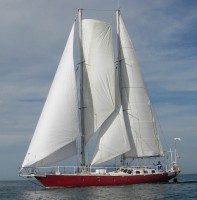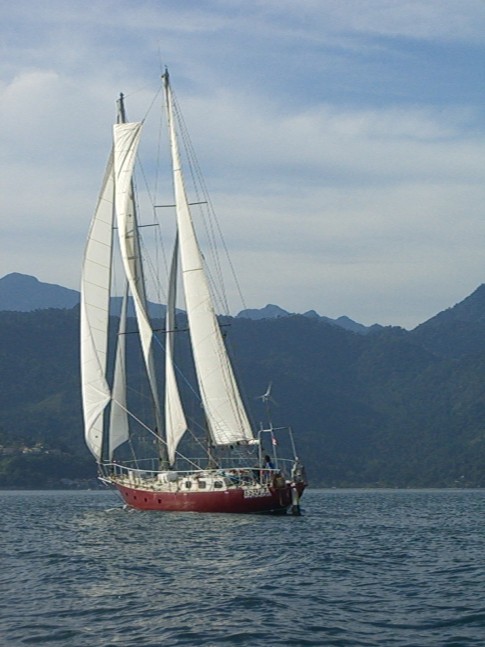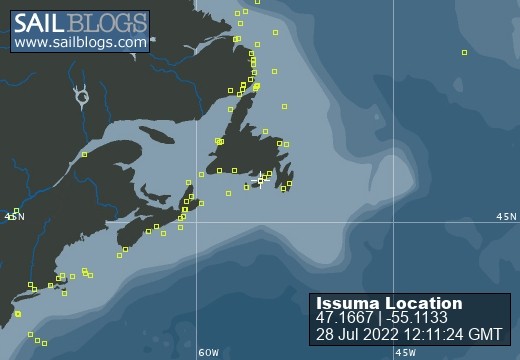
Issuma
28 July 2022
28 July 2022
08 May 2022
18 April 2022
07 April 2022
04 March 2022
17 February 2022 | Little Bay, Marystown, Newfoundland, Canada
16 February 2022
09 February 2022
06 February 2022 | Little Bay, Marystown, Newfoundland, Canada
05 February 2022 | Little Bay, Marystown, Newfoundland, Canada
01 February 2022 | Little Bay, Marystown, Newfoundland, Canada
30 January 2022 | Little Bay, Marystown, Newfoundland, Canada
25 January 2022 | Little Bay, Marystown, Newfoundland, Canada
24 January 2022 | Duricle Cove
17 January 2022
11 September 2021 | Little Bay, Marystown, Newfoundland, Canada
27 August 2021 | Grey River
26 August 2021 | Grand Bruit
26 July 2021 | Isle Valen
The Fisherman
07 April 2009
Richard

The fisherman sail is a four-cornered sail that sets high up, between the masts of a schooner. The name fisherman comes from the use of schooners for fishing off the east coast of North America, where fisherman would hang their nets to dry between the masts. Later, sails put up in their place were called fisherman sails.
The fisherman sail is one of the nice things about the schooner rig, as it is not quite as difficult a sail to handle as a spinnaker (the multicolored balloon-like sails generally set poled out), and gets sail area up high, where there is more wind.
Originally, the fisherman on this boat was set from a roller-furling rig on the aft side of the foremast. That never worked well, as the roller-furling rig didn't entirely fit the sail, and setting the sail involved climbing 12m up the mast to pull the sail out of the furler. Instead of using the roller-furling rig, I had slides put on the luff (leading edge of the sail), so the fisherman is slid up and down the foremast for raising and lowering the sail. Keeping the luff attached to the foremast makes it much easier to raise and lower the fisherman by oneself.
Because I was not using the original furling mechanism, I started setting the fisherman upside-down from how it had been set before (it fit the space now available better that way). This resulted in different parts of the sail chafing against the wires of the rigging. So I had more chafe patches put on the sail to prevent the chafe from damaging it.
In Argentina, I asked a sailmaker to change the shape of the top, so that it fit the space even better. I wanted a panel added to the top, so the whole sail would be bigger, as well as one top corner cut down so it would be possible to raise it to the top of both masts. The sailmaker pointed out it would be easy to cut down one corner, but difficult to add to the sail. So the corner was cut down and the sail made slightly smaller.
I'm experimenting with how high I want the sail now (highest for getting the sail where there is the most wind, but the higher it is the harder it is to raise it without anything getting caught), which is why it isn't quite at the top of the masts in this picture. Raising it up is also going to change where the sail chafes against the rigging wires, so will involve some new chafe patches. The dark line in the sail is where the sail has rubbed against the rigging wires. After sailing with this for a while, I'll have a new line in the sail to look at to see where to put the chafe patches.
The fisherman sail is one of the nice things about the schooner rig, as it is not quite as difficult a sail to handle as a spinnaker (the multicolored balloon-like sails generally set poled out), and gets sail area up high, where there is more wind.
Originally, the fisherman on this boat was set from a roller-furling rig on the aft side of the foremast. That never worked well, as the roller-furling rig didn't entirely fit the sail, and setting the sail involved climbing 12m up the mast to pull the sail out of the furler. Instead of using the roller-furling rig, I had slides put on the luff (leading edge of the sail), so the fisherman is slid up and down the foremast for raising and lowering the sail. Keeping the luff attached to the foremast makes it much easier to raise and lower the fisherman by oneself.
Because I was not using the original furling mechanism, I started setting the fisherman upside-down from how it had been set before (it fit the space now available better that way). This resulted in different parts of the sail chafing against the wires of the rigging. So I had more chafe patches put on the sail to prevent the chafe from damaging it.
In Argentina, I asked a sailmaker to change the shape of the top, so that it fit the space even better. I wanted a panel added to the top, so the whole sail would be bigger, as well as one top corner cut down so it would be possible to raise it to the top of both masts. The sailmaker pointed out it would be easy to cut down one corner, but difficult to add to the sail. So the corner was cut down and the sail made slightly smaller.
I'm experimenting with how high I want the sail now (highest for getting the sail where there is the most wind, but the higher it is the harder it is to raise it without anything getting caught), which is why it isn't quite at the top of the masts in this picture. Raising it up is also going to change where the sail chafes against the rigging wires, so will involve some new chafe patches. The dark line in the sail is where the sail has rubbed against the rigging wires. After sailing with this for a while, I'll have a new line in the sail to look at to see where to put the chafe patches.
Comments
| Vessel Name: | Issuma |
| Vessel Make/Model: | Damien II, 15m/50' steel staysail schooner with lifting keel |
| Extra: | Designed for Antarctica. Built in France by META in 1981. Draft 1.3m/4.5' with keel up, 3.2m/10.5' with keel down. More details at http://www.issuma.com/rhudson/issumaboat/IssumaDetails.htm |
| Home Page: | http://www.issuma.com/rhudson/ |
| Social: |



